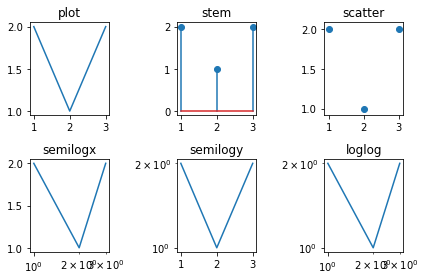3. The Jupyter notebook cheat sheet
This document will be available to you during tests and exams
3.1. Table of Contents
[1]:
import tbcontrol
tbcontrol.expectversion('0.1.2')
3.2. Numeric
[2]:
import numpy
import scipy
[3]:
a = numpy.array([1, 2, 3])
[4]:
t = numpy.linspace(0, 10)
3.3. Basic plotting functions
[5]:
import matplotlib.pyplot as plt
%matplotlib inline
[6]:
plotfuncs = [plt.plot,
plt.stem,
plt.scatter,
plt.semilogx,
plt.semilogy,
plt.loglog]
for i, func in enumerate(plotfuncs, 1):
plt.subplot(2, 3, i)
func([1, 2, 3], [2, 1, 2])
plt.title(func.__name__)
plt.tight_layout()

3.4. Symbolic manipulation
3.4.1. Imports
[7]:
import sympy
sympy.init_printing()
Symbol definitions
[8]:
s = sympy.Symbol('s') # A single symbol
tau, K_c = sympy.symbols('tau K_c', positive=True) # we can use real=True or complex=True for other kinds of variables
Example controller and system
[9]:
Gc = K_c*((tau*s + 1) / (tau*s))
GvGpGm = 5 / ((10*s + 1)**2)
3.4.2. Working with rational functions and polynomials
We often want nice rational functions, but sympy doesn’t make expressions rational by default
[10]:
chareq = GvGpGm*Gc + 1
chareq
[10]:
The cancel function forces this to be a fraction. collect collects terms.
[11]:
chareq = chareq.cancel().collect(s)
chareq
[11]:
In some cases we can factor equations:
[12]:
chareq.factor(s)
[12]:
Obtain the numerator and denominator:
[13]:
sympy.numer(chareq), sympy.denom(chareq)
[13]:
If you want them both, you can use
[14]:
chareq.as_numer_denom()
[14]:
Convert to polynomial in s
[15]:
numer = sympy.poly(sympy.numer(chareq), s)
Once we have a polynomial, it is easy to obtain coefficients:
[16]:
numer.all_coeffs()
[16]:
Calculate the Routh Array
[17]:
from tbcontrol.symbolic import routh
[18]:
routh(numer)
[18]:
To get a function which can be used numerically, use lambdify:
[19]:
f = sympy.lambdify((K_c, tau), K_c + tau)
[20]:
f(1, 2)
[20]:
3.4.3. Functions useful for discrete systems
[21]:
z, q = sympy.symbols('z, q')
[22]:
Gz = z**-1/(1 - z**-1)
Gz
[22]:
Write in terms of positive powers of \(z\):
[23]:
Gz.cancel()
[23]:
Write in terms of negative powers of \(z\):
[24]:
Gz.subs({z: q**-1}).cancel()
[24]:
Inversion of the \(z\) transform
[25]:
from tbcontrol.symbolic import sampledvalues
[26]:
sampledvalues(Gz, z, 10)
[26]:
3.5. Equation solving
3.5.1. Symbolic
[27]:
x, y, z, a = sympy.symbols('x, y, z, a')
residuals = [x + y - 2, y + z - a, x + y + z]
unknowns = [x, y, z]
sympy.solve(residuals, unknowns)
[27]:
3.5.2. Numeric sympy
[28]:
residuals = [2*x**2 - 2*y**2, sympy.sin(x) + sympy.log(y)]
unknowns = [x, y]
sympy.nsolve(residuals, unknowns, [1, 3])
[28]:
3.5.3. Numeric
[29]:
import scipy.optimize
[30]:
def residuals(unknowns):
x, y = unknowns
return [2*x**2 - 2*y**2, numpy.sin(x) + numpy.log(y)]
[31]:
starting_point = [1, 3]
[32]:
residuals(starting_point)
[32]:
[33]:
scipy.optimize.fsolve(residuals, starting_point)
[33]:
array([-2.21910715, 2.21910715])
3.6. Matrix math
3.6.1. Symbolic
[34]:
G11, G12, G21, G22 = sympy.symbols('G11, G12, G21, G22')
Creation
[35]:
G = sympy.Matrix([[G11, G12], [G21, G22]])
G
[35]:
Determinant, inverse, transpose
[36]:
G.det(), G.inv(), G.T
[36]:
Math operations: Multiplication, addition, elementwise multiplication:
[37]:
G*G, G+G, G.multiply_elementwise(G)
[37]:
3.6.2. Numeric
Creation
[38]:
G = numpy.matrix([[1, 2], [3, 4]])
Determinant, inverse, transpose
[39]:
numpy.linalg.det(G), G.I, G.T
[39]:
(-2.0000000000000004, matrix([[-2. , 1. ],
[ 1.5, -0.5]]), matrix([[1, 3],
[2, 4]]))
Math operations: Multiplication, addition, elementwise multiplication:
[40]:
G*G, G+G, G.A*G.A
[40]:
(matrix([[ 7, 10],
[15, 22]]), matrix([[2, 4],
[6, 8]]), array([[ 1, 4],
[ 9, 16]]))
[ ]: